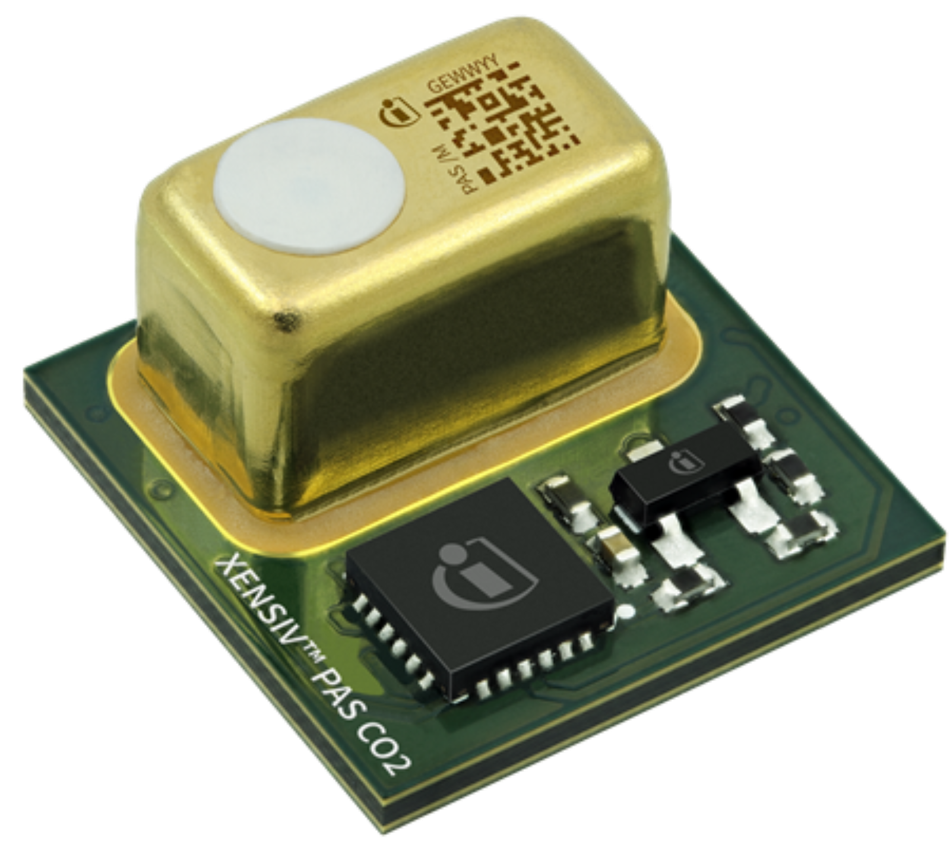CO2 sensors are an IoT Applications must-have
Article #2 of the Enabling IoT Series. CO2 sensors are among the most integral elements of such IoT applications.
This is the second article in a 6-part series exploring the technologies enabling the cutting-edge IoT.
We are living in an era of rapid climatic change and rising carbon emissions, where governments and enterprises are seeking novel ways to improve their environmental performance. In this context, the Internet of Things (IoT) computing paradigm enables many technological solutions that reduce CO2 emissions and improve sustainability.
Most “green” IoT solutions employ sensing solutions that understand the environmental context and trigger actions that lead to emissions reduction. CO2 sensors are among the most integral elements of such IoT applications. They enable IoT systems to monitor the concentration of carbon monoxide in the atmosphere and are deployed in various settings such as homes, buildings, and vehicles. Moreover, CO2 sensors can be used to detect harmful gases in industrial settings such as gas engines, factories, and oil refineries.
CO2 sensors for IoT-based Air Quality Monitoring
CO2 sensors enable a variety of applications in different sectors, including applications that detect CO emissions to avoid harm to human health. Many such applications deal with air quality monitoring in buildings. Air quality monitoring is one of the most prominent functionalities in the thriving markets of smart buildings, smart cities, and facilities management. For instance, modern cities are characterized by very high CO2 concentration, which is usually far above what we are used to breathe at home of at work. Hence, air quality monitoring is key to offering urban planning and smart healthcare services for citizens at risk. Likewise, contemporary office environments offer air quality monitoring functionalities towards boosting workers’ health and well-being. The importance of air quality monitoring has been significantly reinforced following the COVID19 pandemic outbreak, as proper air quality is a key to avoiding viral transmission and related infections.
IoT solutions for air quality monitoring make use of IoT devices that are equipped with Co2 sensors. The deployment of such devices allows users to monitor their own health by measuring the CO2 level in homes, offices, and other environments. This allows them to know when it's time for a change in air quality levels or if there's something else wrong with their environment (e.g., mold). In principle, CO2 sensors enhance IoT applications with functionalities in one or both of the following directions:
- Health protection: CO2-enabled IoT solutions provide the means for monitoring CO2 levels in real-time to make sure that there are no safety issues for people who spend time in the spaces where the IoT devices are installed. This can be useful for healthcare and wellbeing applications such as knowing whether your employees are safe when they work or if your customers feel comfortable when they visit your store.
- Saving energy and reducing costs: In smart buildings, CO2 sensors help increasing energy efficiency by reducing CO2 emissions and electricity consumption costs. For example, by installing Co2 sensors in office spaces and analyzing the data collected through them, facility managers can optimize the operations of air sanitization devices.
CO2 Sensor Types
There is a variety of CO2 sensors, which operate in different ways. The most prominent types of CO2 sensors are:
1. PAS (photoacoustic spectroscopy) sensors
Conventional PAS sensors use a laser to measure how much CO2 is in the air and convert it into an electrical signal. They are popular for air quality monitoring because they can detect lower concentrations of CO2 than other types of gas sensors. Another advantage of PAS technology is that it does not require calibration. Instead, PAS systems rely on the fact that different gases absorb light at different wavelengths. Thus, by measuring how much light passes through a gas sample, they make it possible to get an accurate reading of how much gas is present in the air around it. The popularity of PAS sensors is also due to that they are fast, accurate and have quite low power consumption.
Infineon provides an innovative PAS sensor for measuring indoor air quality, namely the XENSIV™ PAS CO2. The sensor operates based on the photo-acoustic effect principle. Specifically, the sensor measures CO2 as follows: Pulses of light from an infrared source pass through an optical filter that is tuned at the CO2 wavelength. Accordingly, the filter absorbs the light and causes CO2 molecules to shake and generate an acoustic effect. XENSIV™ PAS includes a MEMS acoustic sensor with a high signal to noise ratio that converts the acoustic output to CO2 readings. The main advantages of XENSIV™ PAS CO2 lie in its smart form factors and plug n’ play features, which make it an ideal choice for CO2 sensing in a variety of applications in areas like building automation, ventilation control and personal assistance.
2. NDIR (non-dispersive infrared) sensors
An NDIR sensor has two main parts — a heater and a detector. The heater emits infrared energy in the form of a beam that travels through the atmosphere towards the detector. Carbon dioxide molecules absorb this energy, thereby increasing their temperature and causing them to radiate more infrared energy back toward the detector. This provides information about the concentration of carbon dioxide in the surrounding area without dispersing it into other gases like nitrogen or oxygen. Based on this principle of operation, NDIR sensors can be used to detect various gases such as methane (CH4), oxygen (O2), nitric oxide (NO), nitrogen dioxide (NO2), or hydrogen sulfide (H2S). NDIR sensors are accurate, easy to use and can be integrated with other IoT devices. For instance, they can detect changes in CO2 levels within seconds, and their readings are typically accurate to 0.1. Like the PAS sensors, they do not require any calibration, which makes them reliable for long-term use. Moreover, they also have a high sensitivity i.e., they can measure small changes in CO2 levels. However, NDIR CO2 sensors are more expensive when compared to other types of CO2 sensors. Also, although they don't require calibration, they do need regular maintenance to ensure they stay in good working order. This is one of the reasons why NDIR sensors can hardly comply with recent regulatory mandates such as the California Energy code for buildings. Furthermore, they have a quite limited range (i.e., no more than 30 meters), which means that multiple devices must be deployed in a facility to get a credible idea about the overall air quality. This is not very convenient if you want to monitor a specific area or zone within a facility, while hindering compliance to regulations that set minimum limits for each sensor’s area coverage.
3. EC (electrochemical) CO2 sensors
An electrochemical CO2 sensor measures the concentration of carbon dioxide (CO2) in the air and converts it into an electrical signal. The process is called electrochemical detection. EC sensors are relatively cheap and easy to use. This makes them a good choice for applications such as home automation, industrial automation, and environmental monitoring. Another benefit of EC sensors is that they are easy to install: They two wires connected from each unit to be powered up, start measuring CO2 levels, and send data back. Nevertheless, EC sensors have also some disadvantages when it comes to monitoring air quality. One of these disadvantages is their limited range of measurement, which is less than what infrared sensors offer and usually not adequate for meeting regulatory mandates. Another disadvantage is their relatively short life span. Specifically, an EC sensor can typically last between three and five years before it needs to be replaced. This means more maintenance and higher operating costs over time.
The selection of the most proper CO2 sensor for an IoT application factors size, performance, and cost constraints. In several cases, there is a need to consider trade-offs associated with these parameters, as there is not always a single best match to a given set of business requirements. Moreover, there are also regulatory requirements that can affect the sensor selection process. As a prominent example, the California Energy Code asks for CO2 sensors with stringent performance requirements for DCV. Compliance to such regulatory requirements is mandatory for a wide range of air quality monitoring applications in sectors like smart homes, smart buildings, smart cities, and facilities management.
Infineon’s XENSIV™ PAS CO2 sensor
Infineon is currently providing XENSIV™ PAS CO2, which is one of the world’s most innovative industrial scale solutions for CO2 sensing based on PAS technology. The solution is based on Infineon’s C02 sensor chip, which leverages cutting-edge MEMS (Micro-Electro-Mechanical Systems) technology to deliver accurate CO2 measurements in real-time. Specifically, the sensor leverages Infineon’s MEMS acoustic sensor that acts as a pressure sensor and can effectively operate at low frequencies. XENSIV™ PAS CO2 integrates a PAS transducer, a microcontroller, and a MOSFET (Metal–Oxide–Semiconductor Field-Effect Transistor). As already outlined, the sensor leverages these components to implement the photo-acoustic effect principle in a reliable way.
The main value proposition of the XENSIV™ PAS CO2 sensor lies in its ability to offer exceptional performance at an affordable price. The accuracy of this PAS solution stems from its ability to provide direct readout of the real CO2 level rather than a simple correlation. Moreover, the sensor is very small in size, as it comes at a very small form factor in a SMD (Surface Mounted Device) package. This facilitates the pervasive deployment of the sensor in smart homes and facility management settings.
Infineon’s PAS CO2 is the only gas sensor in the market that meets all the mandatory requirements of the California Energy code for smart buildings. Fully in-line with the code’s requirements, the sensor is certified to meet an accuracy of ±75 ppm or less at 600 ppm and 1,000 ppm concentration when measured at sea level and an ambient temperature of 25°C. Moreover, it is factory configured to require calibration no more than once every five years. Also, in cases where CO2 levels beyond certain thresholds are detected, the sensor triggers a ventilation system that resets air quality to healthy and acceptable levels. Likewise, the XENSIV™ PAS CO2 sensor covers up to 10,000 square feet of floor space with a minimum of one sensor for this space and with an installation height of 3 ft to 6 ft above occupant head levels. These characteristics make the sensors an ideal choice for home, office and public space deployments that achieve significant energy savings, optimize CO2 emissions, and ensure a healthy and comfortable environment for tenants. Most importantly, the sensor ensures full and cost-effective compliance to applicable regulations like the California energy code.
CO2 Sensing in Practice
The XENSIV™ PAS CO2 empowers a wide range of IoT deployments in smart homes, smart cities, smart buildings, as well as healthcare and other industrial settings. In particular, the deployment of this sensing solution within a residential or commercial real estate facility can deliver multiple benefits, including:
- Energy Efficiency and Cost Reduction: The deployment of XENSIV™ PAS CO2 sensor enables energy efficient operations, given that CO2 emissions are directly related to energy consumption and therefore the cost of running your facility or business. Detecting high levels of CO2 can help you identify poor energy management practices in your operations, which can lead to significant savings on your utility bills. At the same time, they can boost facility managers efforts to achieve ambitious sustainability goals and to comply with relevant regulations such as the Energy Performance of Buildings Directive in the European Union, the California Energy Code, and the Energy Conservation Code in New York City.
- Healthcare and Well Being: – High levels of CO2 can cause headaches, dizziness, and nausea. Using XENSIV™ PAS CO2, one can monitor indoor air quality (IAQ) in homes offices and hospitals to ensure that patients and staff don't suffer from these symptoms while they work or visit the establishment.
- Smart Building Control: Many buildings use natural gas as part of their heating systems. This increases the amount of CO2 emitted into the atmosphere and contributes to climate change through increased greenhouse gas emissions. The monitoring of temperature, humidity, and other factors inside a building enables facility managers to adjust the operation of HVAC (Heating, Ventilation and Air Conditioning) systems to reduce these effects by using more renewable energy. To this end, CO2 sensors like XENSIV™ PAS CO2 are integrated within IoT devices such as smart thermostats.
Overall, CO2 sensors enhance IoT applications with various value-added and ROI (Return on Investment) generating functionalities in the areas of smart homes, smart buildings, facilities management, as well as other industrial settings. In the years to come, CO2 sensing will become an integral functionality of IoT systems in these areas. With its XENSIV™ PAS CO2 sensor, Infineon is delivering world class C02 functionalities at affordable prices. Infineon’s CO2 sensing devices can set your IoT solution apart from the rest and help you excel in a highly competitive landscape.
To learn more about Infineon’s XENSIV™ PAS CO2 sensor, register to attend this on-demand webinar: How to optimize energy efficiency & operation costs of smart homes and buildings by accurately measuring CO2 concentration.
This is the second article in a 6-part series exploring the technologies enabling the cutting-edge IoT.
The first article explains why radar sensors are powerful enablers for intelligent IoT applications.
The third article looks at how Time of Flight (ToF) sensors are used for this purpose and are changing the way we can interact with VR, and other video technologies.
The forth article looks at how industrial enterprises are moving to a new approach to asset management, namely predictive maintenance by leveraging powerful new sensors and data.
The fifth article explains how MEMS microphones can deliver high-quality sound in an ultra-small form-factor.
About the sponsor: Infineon Technologies
Infineon Technologies AG is a world leader in semiconductor solutions that make life easier, safer and greener. Microelectronics from Infineon are the key to a better future. With around 50,280 employees worldwide, Infineon generated revenue of about €11.1 billion in the 2021 fiscal year (ending 30 September) and is one of the ten largest semiconductor companies worldwide. To learn more click here.




